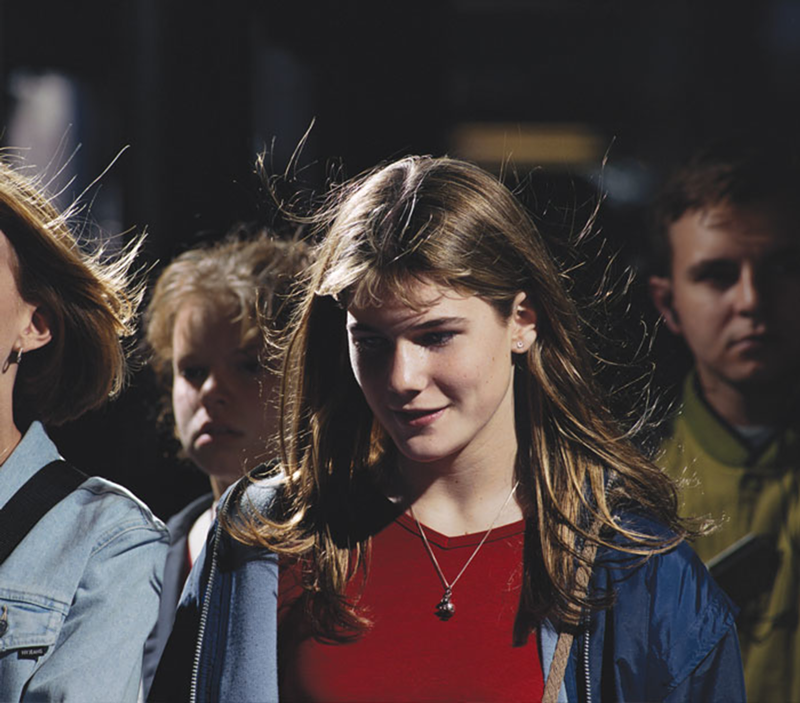One purpose of Eyes on the Street, the Cincinnati Art Museum’s look at 21st century street photography, is to reveal how the phrase itself has evolved since the mid-20th century. The show, part of the citywide FotoFocus Biennial, opens Saturday and runs through Jan. 4.
The mid-20th century was when street photography became well known, thanks to photographers like Henri Cartier-Bresson, Garry Winogrand and others. Armed with unobtrusive hand-held cameras, they rapidly snapped pictures of passersby, searching for unstudied compositions, spontaneous portraiture that captured busy life’s rhythms and colors.
It was also when Jane Jacobs wrote 1961’s landmark The Death and Life of Great American Cities, a plea for a humanist, organic approach to urban renewal that recognized the importance of street life or “eyes on the street” to a city’s survival, rather than expressways and new office towers.
Brian Sholis, CAM’s associate photography curator, studied that book as an undergraduate at Boston University and never forgot it. Now 35, he’s made that phrase the title of the first exhibit he’s curated since coming to the museum last year.
“Her book is largely about the charms of 1950s Greenwich Village, which is where she lived, and she used the term ‘eyes on the street’ to refer to a mother looking out of a window on her child playing on the sidewalk, or a baker sweeping out the front of his storefront and able to keep an eye on things,” Sholis says. “It was a safety mechanism, in a way.”
But now the term means something very different — something potentially much more ominous.
“In the 21st century, for better or worse, there are fewer people at home during the day and we’ve offloaded a lot of that ‘eyes on the street’ to surveillance cameras,” he says.
At the same time, those cameras fill many with unease.
“When you read newspaper stories about cameras in public places, they have negative connotations about the ‘surveillance society’ or about people’s privacy rights being infringed upon,” Sholis says.
“I think artists in this show respond to these 21st century conditions with what can be described as a more cosmopolitan approach. Diversity and the sort of strangeness of encounters that happen in public spaces don’t always have to be a negative thing.”
To that end, Sholis has selected some 30 pieces from 10 international artists for this show — Olivo Barbieri of Italy; Philip-Lorca diCorcia, a New York-based American; Jason Evans of London; Paul Graham, British but New York-based; Mark Lewis, a London-based Canadian; Barbara Probst, a New York-based German; Jennifer West, an L.A.-based American; Michael Wolf, a German based in Paris and Hong Kong; and Jill Magid and James Nares, both New York-based Americans.
Of the 30 pieces, five are video and/or filmworks, four of which are large-scale. And the still pieces can be very planned.
Magid addresses “surveillance society” head-on in her art in the show, Sholis says. For the 2004 Liverpool Biennial, she worked with the police department’s Citywatch system of 242 surveillance cameras.
“In a video called ‘Trust,’ she called the policeman who was operating the cameras in the surveillance center and had dialogue with him while she closed her eyes and navigated Liverpool’s busiest city streets,” Sholis says.
“He tells her, ‘There’s somebody approaching in front of you, beware of the person on left, back up. … She later described it as one of the most intimate encounters she ever had because he’s literally whispering into her ear [she had an earpiece] and telling her where to go for her own safety.”
Another artist in the show, diCorcia, is represented by photos from a 1999-2001 series he did called Heads, where he put a strobe flash under some scaffolding in Times Square and then, from a half block away, used a large-format camera with a powerful lens to capture people walking underneath.
“The flash was hooked to radio control so he could set it off,” Sholis says. “It was powerful enough it blacked out everything else around it and isolated these people. He kind of created a studio in the street but had no control over who was moving through.”
So 21st century street photographers are dealing with techniques and issues far different from their forebears.
“What unites them is they’re incredibly attentive and able to reveal things that we might not otherwise see because the street is such a kinetic and dynamic place,” Sholis says.
Photographer Graham will give a free lecture at the museum at 7 p.m. Oct. 23 to discuss his work in Eyes on the Street.
CONTACT STEVEN ROSEN: [email protected]


